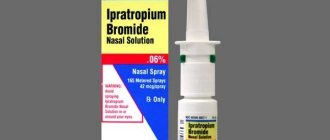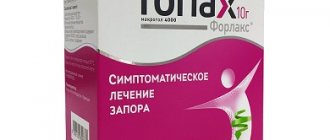Pharmacodynamics
Omeprazole inhibits the enzyme H+-K+-ATPase (“proton pump”) in the parietal cells of the stomach and thereby blocks the final stage of hydrochloric acid synthesis. This leads to a decrease in the level of basal and stimulated secretion, regardless of the nature of the stimulus. After a single oral dose of the drug, the effect of omeprazole occurs within the first hour and continues for 24 hours, the maximum effect is achieved after 2 hours. In patients with duodenal ulcer, taking 20 mg of omeprazole maintains intragastric pH = 3 for 17 hours. After stopping the intake of the drug, secretory activity is completely restored after 3–5 days.
Prevention of ulcers and gastritis
- All prevention of gastritis and ulcers is aimed at protecting the stomach and gastrointestinal tract as a whole from unfavorable factors that can become a trigger for the development of gastritis and ulcers. The very first thing is a balanced diet, in which “harmful” foods are excluded or strictly limited: fried foods, smoked and spicy foods, spices, semi-cooked and raw dishes from meat, poultry and fish, alcohol and smoking.
Important: Tobacco smoke spreads throughout the circulatory system instantly and, having a negative effect on blood vessels, can cause spasm, including spasm of the stomach vessels. Which can worsen the quality of the organ’s work.
- The temperature of the food is also important. Too cold or too hot - drinks and solid foods can injure not only the gastric mucosa, but also the esophagus. Which can also cause serious illness.
- The diet in general is also important. Long hungry breaks, constant overeating to the point of “breathing hard”, different meal times, eating before bed - all this is a sure harbinger of imminent problems not only with the stomach, but also with the nervous system.
- Important: do not overuse medications and reach for the first aid kit at the slightest provocation. Uncontrolled use of vitamins, medications and dietary supplements is also a direct path to gastrointestinal disorders.
Interesting Facts:
- It takes 7-10 seconds for food to enter the stomach.
- The stomach of an adult can hold 1.5 liters of liquid
- The stomach is not able to “stretch”. Even after overeating, he is able to return to his true size.
- The muscles of the stomach are so strong that even if we eat upside down, the food will fall where it is needed and remain there.
- The concentration of hydrochloric acid in the stomach is so high that if there were no protective substances in the gastric juice and mucous membrane, it would burn out its own stomach. The stomach acidity coefficient (pH) is 1.2. Which allows you to digest small bones, wood and even plastic!
- The stomach is very closely connected with the parts of the brain that are responsible for emotions. Thus, our emotions can directly influence the functioning of the stomach. The psychosomatics of stomach diseases says that if there is a disease, it means that a person does not “digest” the situation or people in his life well.
So keep an eye on your emotions to stay healthy and happy!
Pharmacokinetics
Omeprazole is rapidly absorbed from the gastrointestinal tract, Cmax in plasma is achieved in 0.5–1 hour. Bioavailability is 30–40%. Plasma protein binding is about 90%. Omeprazole is almost completely metabolized in the liver. T1/2 - 0.5–1 hour. Excreted mainly by the kidneys in the form of metabolites. In chronic renal failure, excretion decreases in proportion to the decrease in creatinine clearance. In elderly patients, excretion decreases and bioavailability increases. In case of liver failure, bioavailability is 100%, T1/2 is 3 hours.
Side effects
In rare cases, the following usually reversible side effects may occur.
From the digestive organs:
diarrhea or constipation, nausea, vomiting, flatulence, abdominal pain, dry mouth, taste disturbances, stomatitis, transient increase in the level of liver enzymes in plasma; in patients with previous severe liver disease - hepatitis (including jaundice), impaired liver function.
From the nervous system:
headache, dizziness, agitation, drowsiness, insomnia, paresthesia, depression, hallucinations; in patients with severe concomitant somatic diseases, in patients with previous severe liver disease - encephalopathy.
From the musculoskeletal system:
muscle weakness, myalgia, arthralgia.
From the hematopoietic system:
leukopenia, thrombocytopenia; in some cases - agranulocytosis, pancytopenia.
From the skin:
itching; rarely (in some cases) - photosensitivity, erythema multiforme, alopecia.
Allergic reactions:
urticaria, angioedema, bronchospasm, interstitial nephritis and anaphylactic shock.
Other:
blurred vision, peripheral edema, increased sweating, fever, gynecomastia; rarely - the formation of gastric glandular cysts during long-term treatment (a consequence of inhibition of hydrochloric acid secretion, which is benign and reversible).
Where do gastritis and ulcers come from?
- It is known that gastritis can begin with the bacterium Helicobacter pylori, which, developing its vigorous activity in the stomach, has a destructive effect on the mucous membrane. Gastritis is a disease in which inflammation occurs. But bacteria are not the only factor in the development of the disease.
- Taking medications, abusing certain painkillers, or taking long-term medications can destroy the gastric mucosa and cause gastritis.
- Another factor influencing the development of gastritis is increased bile secretion and its reflux into the stomach. We can talk about dysfunction of the liver, which, as part of the digestive system, cannot but affect the gastrointestinal tract.
- There is such a thing as eosinophilic gastritis. which is allergic in nature. In other words, an allergy to some foods does not manifest itself by external signs, but develops on the mucous membrane inside. Many people think that this is a banal intolerance to some foods, but in fact, this can actually mask an allergy.
- And the icing on the cake is the nutrition. The key reason for the development of not only gastritis and ulcers, but also other diseases not related to the gastrointestinal tract. Chemical compounds, preservatives, improper processing of foods, spicy, sour, fatty foods, incorrectly combined foods and lack of culture and diet are sure harbingers of stomach diseases.
Symptoms of gastritis and gastrointestinal diseases
Gastritis can occur in acute outbreaks, or it can take a protracted, sluggish nature, acquiring a chronic form, developing into an ulcer.
Gastric ulcer is a disease in which local defects in the gastric mucosa appear (sometimes involving the submucosal layer). Such defects appear due to excessive production of hydrochloric acid in the stomach, pepsin and bile reflux. The prolonged influence of which on the walls and mucous membrane of the stomach causes trophic disorders in its areas. When to be wary
- Nausea that does not depend on food intake or time of day
- Vomiting, vomiting with poorly digested food remains, long after a meal; vomiting with blood particles
- Pain in the solar plexus and epigastric region is dull, encircling, aching and pressing
- Hunger pain or pain that starts immediately after eating
- Stool disorders
- Heartburn, heartburn with pain, immediately after eating any food.
- Sour taste in mouth, sour belching, frequent belching
- Heaviness and discomfort in the stomach after eating;
- Thick gray or whitish coating on the tongue
- Sour smell and taste in mouth
- Bloating (combined with nausea and other stomach symptoms)
- Feeling of thirst and dry mouth
- General weakness and increased fatigue
- Headache and low-grade fever
IMPORTANT: In acute stages, gastritis can be confused with attacks of ulcers or pancreatitis.
Therefore, it is important to seek medical help as quickly as possible, because the latter can be life-threatening. Medicine for gastritis Omeprazole
A medicine to reduce the production of hydrochloric acid in the stomach. The general therapeutic effect is aimed at protecting the damaged mucous membrane of the organ from the action of an aggressive environment. It is used in complex therapy for the treatment of gastritis, erosions and gastric ulcers. Indicated for other pathological conditions of the gastrointestinal tract.
Composition of omeprazole
The main active ingredient is omeprazole. The amount of the substance in different release forms is presented differently. So the drug has 2 forms of release - capsules and powder for preparing a solution for injection (lyophilisate).
Omeprazole capsules
One capsule contains 20 mg of active ingredient. Intended for oral administration.
It is worth noting that there are also capsules in a dosage of 10 mg.
The only over-the-counter form that is suitable for preventing relapses of gastritis and ulcers. Lyophilisate Omeprazole
One bottle contains 40 milligrams of the substance. A solution for injection (dropper) is prepared from the dosage form intravenously. The course of omeprazole depends on the severity of the disease, and can be taken for a long time (up to 8 weeks) under the supervision of a specialist. The daily dose of the drug ranges from 10 to 80 mg; frequency of use - 1-2 times/day.
Indications
- Gastric and duodenal ulcers, both in the acute stage and to prevent relapse;
- Inflammation caused by the bacterium Helicobacter pilory
- Inflammation of the mucous surface of the esophagus due to the entry of stomach contents into it
- Erosion of the esophagus
- Pathologies developing against the background of increased production of hydrochloric acid
- Frequent use of non-steroidal anti-inflammatory drugs (Nise, ibuprofen, ketanov, ketorol).
Contraindications
- Age up to eighteen years.
- Pregnancy and breastfeeding.
- Individual intolerance to the components of the drug
Side effects
- From the digestive system: constipation, bloating, change in stool consistency, nausea and vomiting, increased production of liver enzymes, dry mouth, impaired taste sensitivity.
- From the side of the central nervous system: increased excitability, cephalalgia, mood swings, dizziness; increased sensitivity to light
- Skin: rashes, inflammation and soreness of the skin, hair loss
- Allergic reactions: Quincke's edema, fever, bronchospasm, anaphylaxis.
- Hematopoietic organs: changes in blood composition, decrease in leukocytes and platelets
- Musculoskeletal system: myasthenia gravis, muscle and joint soreness
- Other symptoms: development of general weakness and loss of strength, swelling, increased sweating
- Women should take it with caution and under control due to possible excessive growth of glandular breast tissue; with long-term use, the formation of glandular cysts in the stomach of a benign nature is possible.
Directions for use and doses
Inside,
with a small amount of water (the contents of the capsule must not be chewed).
Duodenal ulcer in the acute phase
- 1 caps. (20 mg) per day for 2–4 weeks (in resistant cases - up to 2 capsules per day).
Gastric ulcer in the acute phase and erosive-ulcerative esophagitis
- 1-2 caps. per day for 4–8 weeks.
Erosive and ulcerative lesions of the gastrointestinal tract caused by taking NSAIDs
- 1 caps. per day for 4–8 weeks.
Helicobacter pylori eradication
- 1 caps. 2 times a day for 7 days in combination with antibacterial agents.
Anti-relapse treatment of gastric and duodenal ulcers
- 1 caps. per day.
Anti-relapse treatment of reflux esophagitis
- 1 caps. per day for a long time (up to 6 months).
Zollinger-Ellison syndrome
— the dose is selected individually depending on the initial level of gastric secretion, usually starting from 60 mg/day. If necessary, the dose is increased to 80–120 mg/day, in which case it is divided into 2 doses.
Omeprazole
Changes in the acidity of gastric juice during treatment with omeprazole can lead to a decrease or increase in the absorption of other drugs, the completeness of absorption of which depends on the acidity of the environment (vitamin B12, posaconazole, erlotinib, ketoconazole, itraconazole, digoxin, iron supplements).
When omeprazole is used concomitantly with HIV protease inhibitors, such as nelfinavir and atazanavir, a decrease in their plasma concentrations is observed. The use of omeprazole in combination with nelfinavir and atazanavir is contraindicated. Administration of omeprazole (20 mg once daily) in combination with digoxin to healthy volunteers resulted in a 10% increase in digoxin bioavailability. Digoxin toxicity has been rarely reported. However, caution must be exercised when prescribing high doses of omeprazole to elderly patients. In this case, patients receiving digoxin therapy should be under close medical supervision.
A decrease in the activity of the clopidogrel metabolite was noted with the simultaneous administration of clopidogrel and omeprazole. The clinical significance of this interaction remains unclear. In this regard, it is not recommended to use omeprazole in combination with clopidogrel.
The absorption of posaconazole, erlotinib, ketoconazole and itraconazole is significantly reduced when co-administered with omeprazole and therefore their clinical effectiveness may be reduced. It is not recommended to use omeprazole in combination with posaconazole, erlotinib, ketoconazole and itraconazole.
Omeprazole is an inhibitor of the CYP2C19 isoenzyme, therefore, the combined use of omeprazole with drugs in the metabolism of which the CYP2C19 isoenzyme is involved, such as warfarin and other vitamin K antagonists, cilostazol, diazepam, phenytoin, may lead to an increase in the concentrations of these drugs in the blood plasma and require a dose reduction .
During the first weeks after starting treatment with omeprazole, it is recommended to monitor the concentration of phenytoin in the blood plasma and continue this monitoring until the end of treatment with omeprazole if the dose of phenytoin is adjusted.
The use of omeprazole in combination with saquinavir/ritonavir resulted in an approximately 70% increase in saquinavir plasma concentrations, which was well tolerated in HIV-infected patients. It was reported that the use of tacrolimus in combination with omeprazole caused an increase in its concentration in blood plasma. It is necessary to carry out enhanced monitoring of the concentration of tacrolimus in plasma, as well as monitoring of renal function (creatinine clearance) and, if necessary, adjust the dose of tacrolimus.
When methotrexate was co-administered with proton pump inhibitors (PPIs), a slight increase in plasma methotrexate concentrations was observed in some patients. When treated with high doses of methotrexate, omeprazole should be temporarily suspended.
The isoenzymes CYP2C19 and CYP3A4 are involved in the metabolism of omeprazole. Concomitant use of drugs that inhibit CYP2C19 and CYP3A4, such as clarithromycin and voriconazole, may cause an increase in omeprazole plasma concentrations as a result of a decrease in metabolic rate. Concomitant treatment with voriconazole leads to an increase in the exposure of omeprazole by more than 2 times. Since high doses of omeprazole are well tolerated, no dose adjustment of omeprazole is usually necessary. Dose adjustment may be required in patients with severe liver dysfunction and with long-term use. Drugs that induce the isoenzymes CYP2C19 and CYP3A4, such as rifampicin and St. John's wort preparations, when used together with omeprazole, can lead to a decrease in its concentration by accelerating metabolism.
When omeprazole is taken together with clarithromycin or erythromycin, the concentration of omeprazole in the blood plasma increases. Co-administration of omeprazole with amoxicillin or metronidazole does not affect the concentration of omeprazole in the blood plasma.
The effect of omeprazole on drugs has not been identified: antacids, theophylline, caffeine, quinidine, lidocaine, propranolol, ethanol.
special instructions
Before starting therapy, it is necessary to exclude the presence of a malignant process (especially with a stomach ulcer), because Treatment, masking symptoms, can delay the correct diagnosis.
Taking with food does not affect effectiveness.
If you have difficulty swallowing a whole capsule, you can swallow its contents after opening or dissolving the capsule, or you can mix the contents of the capsule with a slightly acidified liquid (juice, yogurt) and use the resulting suspension for 30 minutes.
In patients with severe liver failure, the daily dose should not exceed 20 mg.








